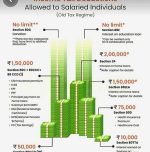Things to know about presumptive taxation income

Presumptive taxation is a concept that offers individuals the convenience of declaring their income at a prescribed rate.
The taxation helps them relieve themselves from the burdensome task of maintaining books of account and undergoing audits.
While it is an easy scheme to comply with, many people struggle to differentiate between the three presumptive concepts outlined in Section 44AD, 44ADA, and 44AE of the Income Tax Act of 1961.
This lack of understanding often leads to incorrect filing of income tax returns, resulting in notices from the government. Therefore, it is better to know the distinctions between these concepts.
Here are the key points and variations between the three sections:
· Under Section 44AD, individuals adopting the presumptive taxation scheme can declare a deemed minimum income. For cash receipts, 8% of the sale or gross receipts are considered income, while for non-cash receipts, 6% of the gross receipts are deemed as income.
· In Section 44ADA, the deemed minimum income is set at 50% of the value of receipts. This section applies to individuals engaged in specified professions, such as legal, medical, engineering, accountancy, and others as notified by the Central Board of Direct Taxes (CBDT).
· Section 44AE applies to individuals who own goods vehicles. For light vehicles, a monthly income of ₹7500 per vehicle is considered, while for heavy vehicles, an income of ₹1000 per ton of weight per vehicle is deemed.
· Applicability varies among the sections. Section 44AD is applicable to resident individuals, Hindu Undivided Families (HUFs), and partnership firms (excluding Limited Liability Partnerships or LLPs) engaged in any business, provided they haven’t claimed certain deductions.
· Section 44ADA is applicable to individuals in specified professions. Section 44AE is applicable to any person, including individuals, HUFs, firms, and companies, as long as they don’t own more than 10 goods vehicles.
· There are certain conditions that need to be met for each section. Under Section 44AD, the total turnover or gross receipts from the business must not exceed ₹2 crores.
· For Section 44ADA, the total gross receipt must not exceed ₹50 lakhs. Section 44AE specifies that the person should not own more than 10 goods vehicles at any time during the year.
· Certain exclusions exist for each section. Section 44AD does not apply to businesses involving plying, hiring, or leasing of goods carriages, agency businesses, or earning income in the nature of commission or brokerage. Section 44ADA is not applicable to professions other than those specified.
· Section 44AE does not apply to businesses covered under Section 44AD or those engaged in any prescribed profession as per Section 44AA(1).
· When opting for presumptive taxation under Section 44AD, individuals are required to follow the scheme for the next five consecutive years.
· Failure to do so will result in the ineligibility of the scheme for the next five years, as well as the obligation to maintain books of account and undergo audits.
Understanding the distinctions between Sections 44AD, 44ADA, and 44AE of the Income Tax Act is crucial for accurate filing and compliance with the presumptive taxation scheme.
By familiarizing themselves with these variations, individuals can confidently navigate the intricacies of income tax regulations and make informed decisions regarding their tax obligations.
Photo by Alexander Grey on Unsplash (Free for commercial use)
Image Reference: https://unsplash.com/photos/-8a5eJ1-mmQ










Leave a Reply